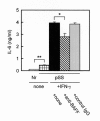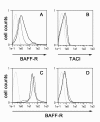Regulatory mechanisms for the production of BAFF and IL-6 are impaired in monocytes of patients of primary Sjögren's syndrome
- PMID: 22018243
- PMCID: PMC3308105
- DOI: 10.1186/ar3493
Regulatory mechanisms for the production of BAFF and IL-6 are impaired in monocytes of patients of primary Sjögren's syndrome
Abstract
Introduction: In this study, we investigated possible aberrations of monocytes from patients with primary Sjögren's syndrome (pSS). We focused on B-cell-activating factor of the TNF family (BAFF) and IL-6 because they are both produced by monocytes and are known to be involved in the pathogenesis of pSS.
Methods: Peripheral monocytes were prepared from both pSS patients and normal individuals. The cells were stimulated in vitro with IFN-γ, and the amounts of IL-6 and soluble BAFF (sBAFF) produced by the cells were quantitated. The effect of sBAFF itself on the production of IL-6 was also studied. To investigate the response of pSS monocytes to these stimuli, the expression levels of the genes encoding BAFF receptors and IL-6-regulating transcription factors were quantitated.
Results: Peripheral pSS monocytes produced significantly higher amounts of sBAFF and IL-6 than normal monocytes did, even in the absence of stimulation. The production of these cytokines was significantly increased upon stimulation with IFN-γ. The elevated production of IL-6 was significantly suppressed by an anti-BAFF antibody. In addition, stimulation of pSS monocytes with sBAFF induced a significant increase in IL-6 production. Moreover, the expression levels of a BAFF receptor and transcription factors regulating IL-6 were significantly elevated in pSS monocytes compared to normal monocytes.
Conclusions: The results of the present study suggest that the mechanisms underlying the production of sBAFF and IL-6 are impaired in pSS monocytes. Our research implies that this impairment is due to abnormally overexpressed IL-6-regulating transcription factors and a BAFF receptor. These abnormalities may cause the development of pSS.
Figures




Comment in
-
How does BAFF activate B cells in patients with autoimmune diseases?Arthritis Res Ther. 2012 Feb 24;14(1):106. doi: 10.1186/ar3729. Arthritis Res Ther. 2012. PMID: 22360881 Free PMC article.
References
-
- Moore PA, Belvedere O, Orr A, Pieri K, LaFleur DW, Feng P, Soppet D, Charters M, Gentz R, Parmelee D, Li Y, Galperina O, Giri J, Roschke V, Nardelli B, Carrell J, Sosnovtseva S, Greenfield W, Ruben SM, Olsen HS, Fikes J, Hilbert DM. BLyS: member of the tumor necrosis factor family and B lymphocyte stimulator. Science. 1999;285:260–263. doi: 10.1126/science.285.5425.260. - DOI - PubMed
-
- Shu HB, Hu WH, Johnson H. TALL-1 is a novel member of the TNF family that is down-regulated by mitogens. J Leukoc Biol. 1999;65:680–683. - PubMed
-
- Schneider P, Mackay F, Steiner V, Hofmann K, Bodmer JL, Holler N, Ambrose C, Lawton P, Bixler S, Acha-Orbea H, Valmori D, Romero P, Werner-Favre C, Zubler RH, Browning JL, Tschopp J. BAFF, a novel ligand of the tumor necrosis factor family, stimulates B cell growth. J Exp Med. 1999;189:1747–1756. doi: 10.1084/jem.189.11.1747. - DOI - PMC - PubMed
Publication types
MeSH terms
Substances
LinkOut - more resources
Full Text Sources
Other Literature Sources
Medical

